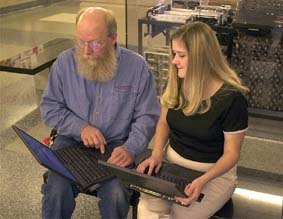|
|
|
|
|
|
INSIDE IOWA STATE November 9, 2001 Online and unpluggedby Diana PoundsYou can take an old-fashioned book out onto the central green and expand your mind. There is no reason you should not also be able to do that with the Web. -- Provost Rollin Richmond
Pockets of wireless computing are appearing all around campus. In recent months, ISU Telecommunications and Instructional Technology Center staff have wired approximately 40 classrooms for wireless computing. Now they're working on public areas, including popular outdoor areas and building lounges and atriums. Wireless computing already is available on the steps of Beardshear and the atrium of the Durham Center. It's coming soon to the plazas outside Parks Library and the Hub, as well as other popular public spots on campus. "Basically, we're working on the area from Memorial Union to MacKay and from Curtiss to Marston," said John Kingland, director of Telecommunications. "We're starting with the core central area and creating a wireless infrastructure for students, faculty and staff." Wireless computing gives ISU computer users the same kind of mobility as cell phone users. If they've got the right kind of computers (see story below) and they're near a transmitter (it's called an "access point") they can connect to the campus network (and the Internet), without cords or cables. Since August, Telecommunications and ITC staff have installed approximately 45 wireless access points, most of them in classrooms. The access points are small devices that transmit radio waves in the same frequencies as microwave ovens and cordless phones. Indoors, their range will cover a large classroom. Outdoors, the range can be several hundred feet. While some may consider wireless computing something of a novelty, Provost Rollin Richmond says wireless technology will prove very useful for the campus community. A good example is the library, "where information now comes electronically across a spectrum of sources," Richmond said. "If you are up in the stacks and want to check on a book, some day you will be able to do it on a laptop, right there in the stacks." In classrooms full of laptop-toting students, instructors might use wireless technology in a number of ways, Richmond said. They could ask students to work a problem online, getting instant feedback on how many answered correctly and incorrectly. They could, as a group, analyze a scientific paper on the Internet. In fields like economics, chemistry and genetics, instructors could work on modeling on their laptops, so that students see exactly how models are derived, Richmond added. Instructors also could encourage class conversation by allowing students to post anonymous comments, for public display. Labs also will be enhanced by wireless computing, Richmond said. "Many scientists routinely use computers to collect and analyze data. They need to be able to use their computers anywhere in the lab, not just where there happens to be an Ethernet outlet." A list of public wireless computing Web sites is available on the Telecommunications Web site (http://www.tele.iastate.edu). "We'll continue to extend the wireless network on campus, so watch the list for updates," Kingland said. Richmond envisions a widespread wireless network on campus. "Students expect universities to be at the leading edge of technology change, especially as it affects their ability to learn," he said. "We are a 'university of science and technology' and our students have even higher expectations. I believe a ubiquitous wireless network will be an important recruiting tool for both students and faculty." What you need for wireless computing For wireless computing at Iowa State, you'll need a computer with a wireless Ethernet card that supports the IEEE 802.11b wireless standard. Additional information can be found on the Telecommunications Web site (http://www.tele.iastate.edu). The card can be ordered through the Microcomputer Product Center (191 Durham) or other computer suppliers. Support is available from the Solution Center, 195 Durham, 296-6000. You also need to be in the vicinity of a "wireless access" point on campus. In addition to public wireless computing areas on campus, some departments have installed wireless computing areas. Officials who would like to consider installing wireless access in their units can get information from the Telecommunications Office. |
|
Ames, Iowa 50011, (515) 294-4111 Published by: University Relations, online@iastate.edu Copyright © 1995-2001, Iowa State University. All rights reserved. |
